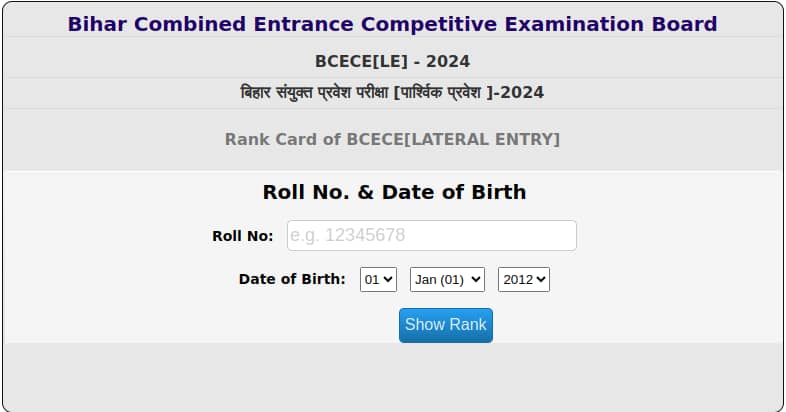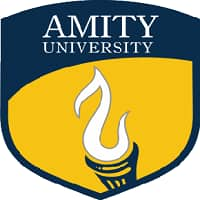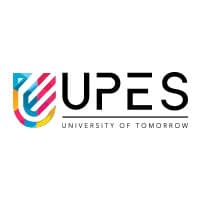UPES B.Tech Admissions 2025
Ranked #42 among Engineering colleges in India by NIRF | Highest CTC 50 LPA , 100% Placements | Last Date to Apply: 28th April
BCECE LE 2025 - BCECEB has commenced the BCECE LE 2025 registration on April 16, 2025. The BCECE LE application form is available on the official website, bceceboard.bihar.gov.in. Interested candidates must apply by May 11, 2025. The authority will hold BCECE LE 2025 on June 8, 2025. Candidates can check the information brochure for BCECE LE 2025 online. It is important to be aware of the eligibility criteria for BCECE LE before filling out the form.
The authority will release the BCECE LE answer key on the official website. The candidates will be able to cross-check their answers with the help of the answer key of BCECE LE 2025. The exam results are expected to be announced in June 2025. Candidates are advised to refer to the previous year BCECE Lateral Entry question papers for practice. It is important to check the syllabus and exam pattern while preparing for the lateral entry exam of BCECE 2025. Based on the marks obtained by the candidates in the entrance exam, they will be invited for counselling. The BCECE counselling 2025 schedule will be released on the website.
Bihar Combined Entrance Competitive Examination Board (BCECEB) is the exam-conducting authority for Bihar Combined Entrance Competitive Examination (Lateral Entry). The exam is held annually. BCECE LE is held for second year admissions in various professional courses of Medical, Engineering, and Agricultural streams in the Institutions of the state of Bihar. This is a state-level examination that is held in offline mode.
Latest: NIRF Engineering Ranking 2024
| Full Exam Name | Bihar Combined Entrance Competitive Examination Lateral Entry |
| Short Exam Name | BCECE LE |
| Conducting Body | Bihar Combined Entrance Competitive Examination Board |
| Frequency Of Conduct | Once a year |
| Exam Level | State Level Exam |
| Languages | English +1 more |
| Mode Of Application | offline +1 more |
| Application Fee | Offline : 2200 +1 more |
| Mode Of Exam | offline |
| Mode Of Counselling | online +1 more |
| Exam Duration | 2 Hours 15 Minutes |
BCECE LE Bihar Combined Entrance Competitive Examination Lateral Entry (session 2025)
Read More
The applicants preparing for the BCECE LE exam are advised to check the eligibility criteria of BCECE LE Engineering 2025 to ensure that they are eligible to apply. Check the below details of BCECE LE Engineering 2025 eligibility criteria:
Age Limit- There is no age limit for appearing for the exam.
Academic Qualification-
Candidate must have passed the Diploma examination with at least 45% marks (40% in case belongs to reserved category) in the relevant branch of Engineering and Technology.
Candidates must have passed B.Sc. Degree from a recognized University with at least 45% marks (40% in case belongs to reserved category) and passed 10+2 examination with Mathematics as a subject.
Students belonging to B.Sc. Stream is required to clear the subjects Engineering Graphics /Engineering Drawing and Engineering Mechanics of the First year Engineering Programme along with the Second year subjects.
Citizenship-
The candidate must be a citizen of India, and also fulfill any one of the following requirements of citizenship
The candidate's parents should be natives of Bihar.
The candidate's parents are residents of some other place but work in Bihar.
Parents of the candidates are refugees who settled in Bihar.
Those candidates whose parents are employee of the pre-partition Bihar Government and whose department has not yet been divided and are still working as its employee in the region of Bihar/Jharkhand.
Whose parents are the employee of Bihar State Government or PSU of the Indian Government
Whose parents are the employee of Central Government and are located at Bihar
The BCECE LE Para Medical eligibility criteria will be released on the official notification. The candidates are required to fulfill the eligibility criteria of BCECE (LE) Para Medical 2023 as prescribed by the authorities. Check the detailed BCECE (LE) Para Medical Eligibility criteria mentioned below:
Age Limit- Candidates applying for BCECE Lateral Entry Para Medical 2023 should be at least 18 years old on December 31, 2023.
Academic Qualification-
Candidate must have passed two years Para Medical Diploma course.
Candidates who are yet to give the exams of second year of Para Medical Diploma course are also eligible to apply provided that they pass before admission.
Candidates can apply for that course of Para Medical only in which they have passed their Diploma. In case that course is not available then they are not eligible to apply for any other course.
Citizenship-
The candidates must a citizens of India, and also fulfill any one of the following requirements of citizenship
The candidate's parents should be natives of Bihar.
The candidate's parents are residents of some other place but work in Bihar.
Parents of the candidates are refugees who settled in Bihar.
Those candidates whose parents are employees of pre-partition Bihar Government and their department has not yet been divided and are still working as its employee in the region of Bihar/Jharkhand.
Whose parents are the employee of Bihar State Government or PSU of Indian Government
Whose parents are the employee of Central Government and are located at Bihar
Medical- Candidates will have to go through a medical checkup by the selected doctors to be eligible for admissions. The candidates will have to pay the fees of medical checkup separately.
Candidates can check the eligibility criteria of BCECE (LE) Pharmacy 2023 to ensure that they are eligible to apply. The detailed BCECE (LE) Pharmacy Eligibility criteria is mentioned below:
Age Limit- Candidates applying for BCECE Lateral Entry Para Medical 2023 should be atleast 18 years old on December 31, 2023.
Academic Qualification-
Candidate must have passed two-year Diploma course in Pharmacy from a recognized University or Institution.
Candidates who are yet to give the exams of the second year of Pharmacy Diploma course are also eligible to apply provided that they pass before admission
Citizenship-
Along with being a citizen of India, the candidate should fulfil any one of the following requirements of citizenship
The candidate's parents should be native of Bihar.
The candidate's parents are residents of some other place but work in Bihar.
Parents of the candidates are refugees who settled in Bihar.
Those candidates whose parents are employee of the pre-partition Bihar Government and their department has not yet been divided and are still working as its employee in the region of Bihar/Jharkhand.
Whose parents are the employee of Bihar State Government or PSU of Indian Government
Whose parents are the employee of Central Government and are located at Bihar
Medical- Candidates will have to go through a medical checkup by the selected doctors to be eligible for admissions. The candidates will have to pay for this medical checkup.

The authorities released the BCECE LE 2025 application form on April 16, 2025 on the official website. Candidates applying for BCECE LE 2025 have to complete the application procedure before the last date. Check the steps below to fill up the application form for BCECE LE 2025. The BCECE LE registration will conclude on April 16, 2025.
Step 1- Registration: In the first step candidates have to complete the registration process by filling in details like contact number, email address, etc. Candidates are advised to enter the correct contact number and email id as the details entered here will be used for further communication.
Step 2- Personal Information: In the next step candidates will have to log in using their registered email id and password. Candidates will have enter personal details in this step. After entering personal details candidates have to click on Save and continue and move further.
Step 3- Upload Photo and Signature: Candidates will have to upload the scanned images of the photograph and signature in the prescribed format. The photograph must be recently clicked with a placard with the name and date of clicking the picture mentioned on it. The dimension of the image should be 3.5 x 4.5cm.
Step 4- Educational Qualification: Candidates have to enter the educational in this section.
Step 5- Preview the application: In this step, candidates have to preview all the details entered by them before submitting it finally.
Step 6- Fee Payment: The candidates have to pay the application fee in online mode or through bank challan. Candidates can pay their fee using a debit card, credit card, internet banking or through bank challan.
Step 7- Download the application form: Candidates are advised to download the application form and preserve it for further reference.
| State | City |
| Bihar | Patna Bhojpur Rohtas Kaimur (Bhabhua) Nalanda Gaya Nawada Buxar Aurangabad Arwal Jahanabad Saran Siwan Gopalganj Vaishali Muzaffarpur Sitamarhi Sheohar East Champaran West Champaran Darbhanga Samastipur Madhubani Saharsa Madhepura Supaul Purnia Katihar Kishanganj Araria Bhagalpur Banka Munger Begusarai Khagaria Jamui Lakhisarai Shekhpura |
Ranked #42 among Engineering colleges in India by NIRF | Highest CTC 50 LPA , 100% Placements | Last Date to Apply: 28th April
Recognized as Institute of Eminence by Govt. of India | NAAC ‘A++’ Grade | Upto 75% Scholarships
The candidates are advised to go through BCECE LE Engineering exam pattern 2025 to get an idea about details of the exam like exam duration, mode, types of questions, marking scheme, etc. The exam pattern of BCECE LE Engineering is given below:
| Parameters | Particulars |
| Mode of the exam | Offline |
| Exam Duration | 2 hours 15 minutes |
| Total Number of Questions | Mathematics (50 Questions), Engineering Mechanics (50 Questions), English (50 Questions) |
| Types of Questions | Multiple Choice Questions |
| Maximum Marks | 600 ( 200 marks for each section) |
| Marking Scheme | 4 marks will be awarded for every correct answer. 1 mark will be deducted for every incorrect response. |
Candidates can check BCECE (LE) Para Medical exam pattern given below to get an idea about details of the exam like exam duration, mode, types of questions, marking scheme, etc.
Parameters | Particulars |
Mode of the exam | Offline |
Exam Duration | 2 hours 15 minutes |
Sections | Anatomy and Physiology (50 Questions), Pathology, Microbiology and Bio chemistry (50 Questions), English (50 Questions) |
Types of Questions | Multiple Choice Questions |
Maximum Marks | 600 ( 200 marks for each section) |
Marking Scheme | 4 marks will be awarded for every correct answer. 1 mark will be deducted for every incorrect response. |
Candidates are advised to go through BCECE (LE) Pharmacy exam pattern to get an idea about details of the exam like exam duration, mode, types of questions, marking scheme, etc. The exam pattern of BCECE (LE) is given below:
| Parameters | Particulars |
| Mode of the exam | Offline |
| Exam Duration | 2 hours 15 minutes |
| Total Number of Questions | Pharmaceutics-I (50 Questions), Pharmaceutics-II (50 Questions), English (50 Questions) |
| Types of Questions | Multiple Choice Questions |
| Maximum Marks | 600 ( 200 marks for each section) |
| Marking Scheme | 4 marks will be awarded for every correct answer. 1 mark will be deducted for every incorrect response. |
Mathematics: Unit 01
Mathematics: Unit 02
Mathematics: Unit 03
Mathematics: Unit 04
Mathematics: Unit 05
Mathematics: Unit 06
Engineering mechanics: Unit 01
Engineering mechanics: Unit 02
Engineering mechanics: Unit 03
Engineering mechanics: Unit 04
Engineering mechanics: Unit 05
Engineering mechanics: Unit 06
Engineering mechanics: Unit 07
Engineering mechanics: Unit 08
Engineering mechanics: Unit 09
Technical english: Unit 01
Technical english: Unit 02
Technical english: Unit 05
Anatomy and physiology: Unit 01
Anatomy and physiology: Unit 02
Pathology, microbiology, and biochemistry: Unit 01
Pathology, microbiology, and biochemistry: Unit 02
Pathology, microbiology, and biochemistry: Unit 03
Technical english: Unit 01
Technical english: Unit 04
Pharmaceutics-I: Unit 01
Pharmaceutics-I: Unit 03
Pharmaceutics-I: Unit 04
Pharmaceutics-I: Unit 05
Pharmaceutics-I: Unit 06
Pharmaceutics-I: Unit 07
Pharmaceutics-I: Unit 08
Pharmaceutics-I: Unit 09
Pharmaceutics-I: Unit 10
Pharmaceutics-I: Unit 11
Pharmaceutics-I: Unit 12
Pharmaceutics-I: Unit 13
Pharmaceutics-I: Unit 14
Pharmaceutics-I: Unit 15
Pharmaceutics-I: Unit 16
Pharmaceutical chemistry-I: Unit 01
Pharmaceutical chemistry-I: Unit 02
Pharmaceutical chemistry-I: Unit 03
Pharmaceutical chemistry-I: Unit 04
Pharmaceutical chemistry-I: Unit 05
Pharmaceutical chemistry-I: Unit 06
Pharmacognosy: Unit 01
Pharmacognosy: Unit 05
Pharmacognosy: Unit 06
Biochemistry and clinical pathology: Unit 02
Biochemistry and clinical pathology: Unit 06
Biochemistry and clinical pathology: Unit 10
Biochemistry and clinical pathology: Unit 11
Biochemistry and clinical pathology: Unit 12
Human anatomy physiology: Unit 03
Human anatomy physiology: Unit 04
Human anatomy physiology: Unit 12
Human anatomy physiology: Unit 17
Human anatomy physiology: Unit 23
Human anatomy physiology: Unit 25
Human anatomy physiology: Unit 27
Human anatomy physiology: Unit 29
Human anatomy physiology: Unit 30
Health education and community pharmacy: Unit 01
Health education and community pharmacy: Unit 02
Health education and community pharmacy: Unit 03
Health education and community pharmacy: Unit 04
Health education and community pharmacy: Unit 05
Health education and community pharmacy: Unit 06
Health education and community pharmacy: Unit 07
Health education and community pharmacy: Unit 08
Health education and community pharmacy: Unit 09
Pharmaceutics-II: Unit 01
Pharmaceutics-II: Unit 02
Pharmaceutical chemistry-II: Unit 01
Pharmaceutical chemistry-II: Unit 02
Pharmaceutical chemistry-II: Unit 03
Pharmacology toxicology: Unit 02
Pharmacology toxicology: Unit 03
Pharmacology toxicology: Unit 04
Pharmacology toxicology: Unit 06
Pharmaceutical jurisprudence: Unit 01
Pharmaceutical jurisprudence: Unit 02
Pharmaceutical jurisprudence: Unit 04
Pharmaceutical jurisprudence: Unit 05
Pharmaceutical jurisprudence: Unit 06
Pharmaceutical jurisprudence: Unit 07
Pharmaceutical jurisprudence: Unit 08
Pharmaceutical jurisprudence: Unit 09
Drug store and business management: Unit 01
Drug store and business management: Unit 02
Hospital and clinical pharmacy: Unit 01
Hospital and clinical pharmacy: Unit 02
Technical english: Unit 01
Technical english: Unit 04
The authorities will issue the admit card of BCECE LE 2025 to the registered candidates on June 1, 2025 on the official website. Candidates have to download the admit card using their roll number and password. Candidates have to carry the admit card of BCECE LE 2025 to the exam centre.
The candidates must note that BCECE Lateral Entry admit card 2025 is a mandatory document. Without admit card no candidate will be allowed to enter the examination hall. On the admit card of BCECE LE 2025 details like the candidate's name, exam centre, exam date and timings, etc. will be mentioned.
BCECE LE admit card download window
Candidates having any error in their BCECE LE 2025 admit card like name, date of birth, etc. will be able to get it corrected by visiting the Exam Controller, BCECE Board Office, Patna (Near Patna Airport) within the specified time. It must be noted that only one chance to make corrections in the BCECE LE admit card 2025 will be provided.
The authority will announce the result of BCECE LE 2025 in June, on the official website. BCECE Lateral Entry Result 2025 will be declared in the form of a merit list. The merit list is declared category-wise, in which the roll number of qualified candidates will be mentioned.
The candidate must note that 35 qualifying marks are required in the English section. However, marks scored in English will not be considered while preparing the merit list. Marks obtained in the other two sections will be taken into consideration while preparing the merit list for BCECE LE 2025.
 Steps to Download BCECE LE Merit List 2025/Rank card
Steps to Download BCECE LE Merit List 2025/Rank cardVisit the official website- bceceboard.bihar.gov.in.
Click on “Rank Card of BCECE (Lateral Entry) – 2025”.
Enter Roll Number and Date of Birth and click on the "Show Rank" button.
Merit list/Rank card will be displayed on the screen.
Download and take a printout.
The exam authority will release the BCECE LE 2025 counselling schedule on the website. Candidates will have to check the BCECE LE result online and apply for the counselling on the basis of their ranks. BCECE LE counselling 2025 will be conducted online as well as offline mode in two rounds. Applicants will be given choice-filling and choice-locking opportunity to choose the desired course and college according to their preference and rank. Candidates will have to get their required certificates and documents verified and present their medical fitness certificate as prescribed. Those candidates will have to report to the allotted institute for document verification and to pay the admission fee to confirm seat required.
06122220230 , 06122225387
Merit Scholarships | NAAC A+ Accredited | Top Recruiters : E&Y, CYENT, Nvidia, CISCO, Genpact, Amazon & many more
100% Placement Record | Highest CTC 54 LPA | NAAC A++ Accredited | Ranked #65 in India by NIRF Ranking 2024 | JEE & JET Scores Accepted | Last Date to Apply: 28th April
To download the admit card of BCECE LE 2025, candidates will have to visit the official website and login to the portal using their application number and date of birth.
The authorities will conduct the BCECE LE 2025 as an offline-pen-paper-based test.
Yes, the authority will provide an opportunity to edit BCECE LE 2025 application from May 13 to 14, 2025.
To download the admit card of BCECE LE 2025, candidates will need their registration number and date of birth.
Candidates have to fill and submit the BCECE LE application form 2025 in online mode.
The authority released the BCECE LE 2025 application form on April 16, 2025.
After passing the BCECE LE (Lateral Entry) Paramedical Exam, the next step is to participate in the counseling process organized by the BCECE Board. Visit the official BCECE Board website (https://bceceboard.bihar.gov.in) for detailed notifications and updates regarding counseling dates and procedures. Start by registering yourself on the counseling portal using your exam details like roll number, rank, and personal information. Once registered, you will need to upload required documents such as your mark sheets, BCECE rank card, domicile certificate, and photo ID. After successful document verification, you can participate in the choice-filling process to select your preferred colleges and courses. Based on your rank and preferences, you will be allotted a seat in the counseling rounds. Follow the instructions for seat acceptance and fee payment within the given timeline. Keep checking the official website for updates and deadlines to avoid missing important steps.
Hello aspirant,
Hope you are doing great...!!!
BCECE:-
The Bihar Combined Entrance Competitive Examination Board (BCECEB) conducts the admissions for Bihar NEET 2021 on the grounds of NEET scores.
Eligibility Criteria:-
Candidates must be a citizen of India
For Bihar MBBS/BDS admission 2021, candidates should fill out the application form to register themselves.
Candidates must be of at least 17 years old as of December 31, 2021.
Candidates who belong to the following domicile categories are eligible for Bihar MBBS 2021 admission:
One whose parent(s) is a permanent resident of India.
Candidates whose parent(s) are refugees in the Bihar state.
Candidates whose parent is not permanent resident of the state but working for the Government of Bihar.
The parents of students who are in a transferable jobs in Bihar and Jharkhand state.
BCECE LE:-
Bihar Combined Entrance Competitive Examination Board Lateral Entry Test.
Eligibility Criteria:-
The board has certain eligibility for BCECE LE 2022 that needs to be met by the candidates for admissions. Candidates can refer to the tables given below to know about the eligibility criteria for second-year Engineering, Para-Medical, and Pharmacy courses. Candidates are advised to check the eligibility criteria before filling out the application form. No candidate will be eligible for final seat allotment if he/she does not fulfill the prescribed eligibility criteria.
For more information, you can visit the following links:-
https://engineering.careers360.com/articles/bcece-le
https://medicine.careers360.com/articles/bihar-mbbs-admission
I hope this helps you!
All the best:)
You can visit to the official website of Bachelor of Science Agriculture College in which you are interested to take admission for applying for admission. Before this you must have completed the eligibility criteria for applying for Bsc agriculture in that college or university. I am mentioning below most basic eligibility criteria and selection criteria:
For MORE information click on mentioned below link:

Among Top 30 National Universities for Engineering (NIRF 2024) | 30+ Specializations | AI Powered Learning & State-of-the-Art Facilities

Ranked #42 among Engineering colleges in India by NIRF | Highest CTC 50 LPA , 100% Placements | Last Date to Apply: 28th April
Ranked #1 Among all Private Indian Universities in QS Asia Rankings 2025 | Scholarships worth 210 CR
A Hero Group Initiative | Up to 100% Scholarships | Highest CTC 32.99 LPA | Average CTC 8.45 LPA | Accepts JEE Score | Last Date: 19th Apr'25
India's Largest University | NAAC A++ Accredited | 100% Placement Record | Highest Package Offered : 2.5 Cr PA | Last Date: 25th Apr'25
100% Placement Record | Highest CTC 54 LPA | NAAC A++ Accredited | Ranked #65 in India by NIRF Ranking 2024 | JEE & JET Scores Accepted | Last Date to Apply: 28th April